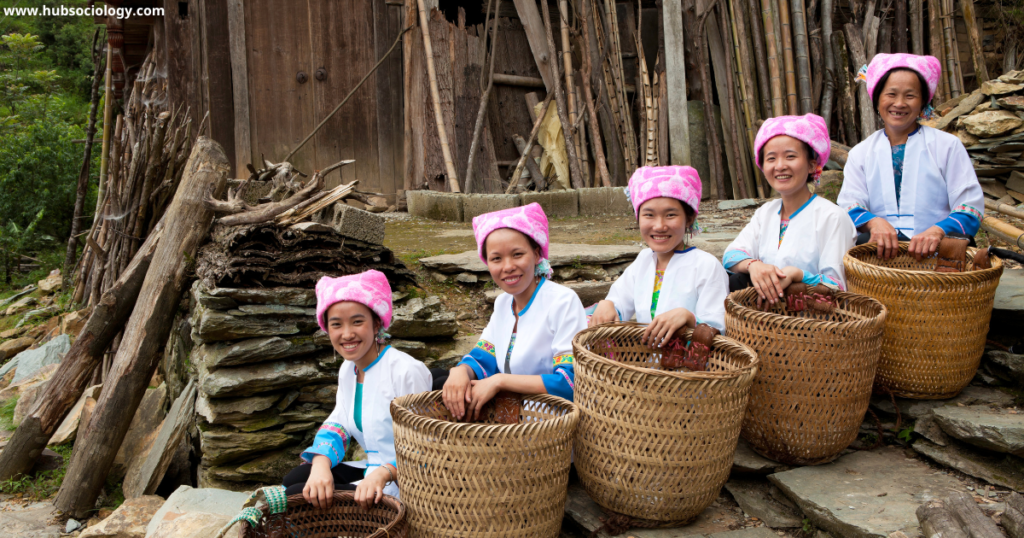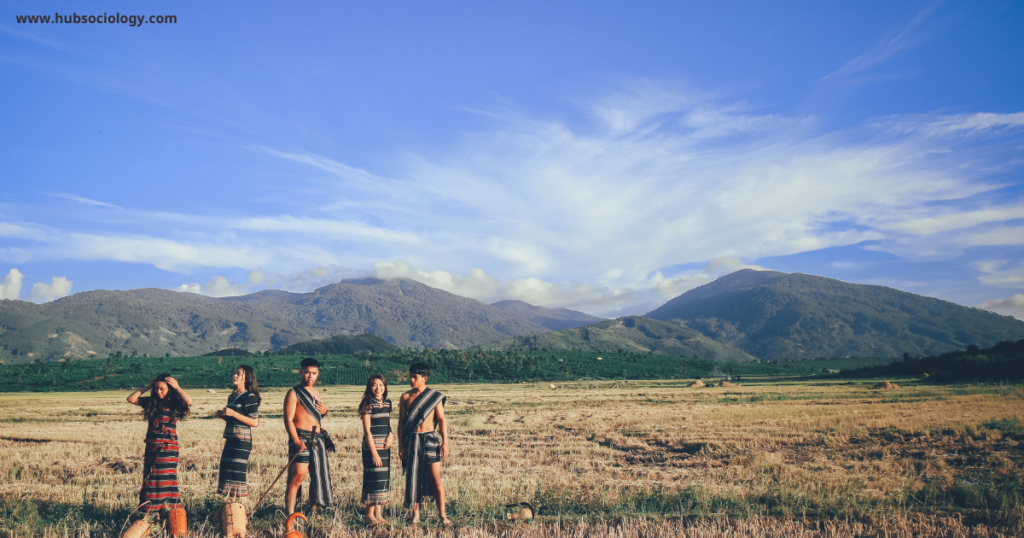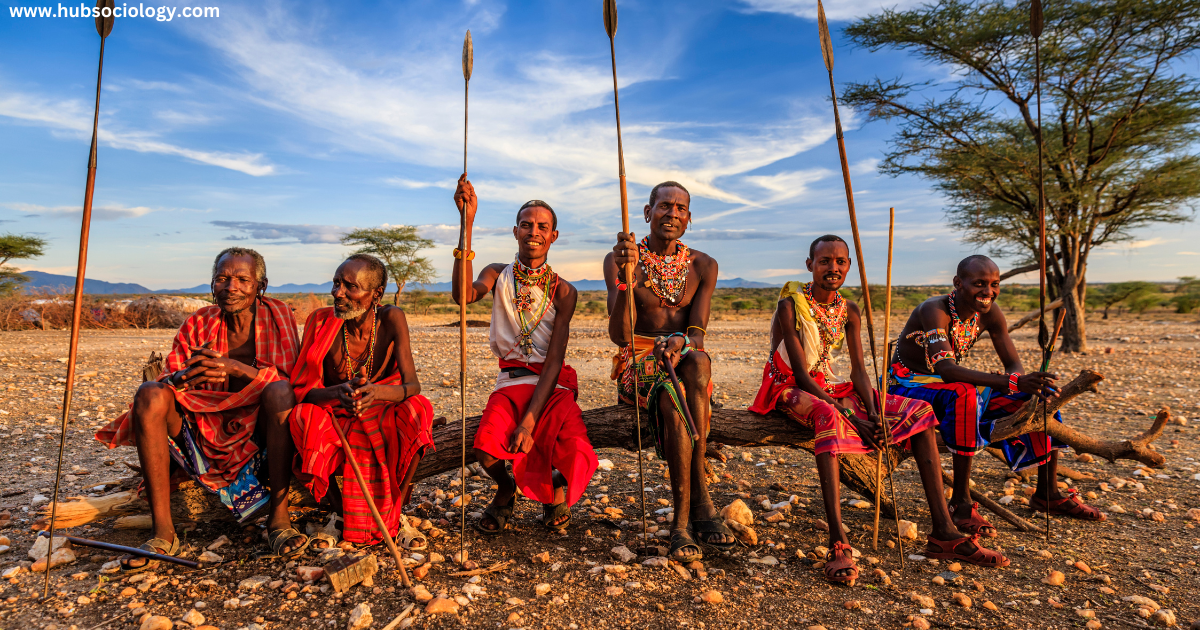Scheduled Tribes (STs) are among the most marginalized and vulnerable communities in India. They represent a significant segment of the population, characterized by distinct cultural, social, and economic identities. The Indian Constitution recognizes these communities as Scheduled Tribes, granting them special protections and privileges to address historical injustices and socio-economic disparities. This article delves into the sociological aspects of Scheduled Tribes, including their definition, criteria for identification, classification, and the myriad problems they face.

Definition of Scheduled Tribes
The term “Scheduled Tribes” refers to indigenous communities that are identified by the Indian government as deserving special protections and benefits due to their socio-economic and educational backwardness. The Constitution of India, under Article 366(25), defines Scheduled Tribes as “such tribes or tribal communities or parts of or groups within such tribes or tribal communities as are deemed under Article 342 to be Scheduled Tribes for the purposes of this Constitution.”
The identification of STs is based on several criteria, including their primitive traits, distinctive culture, geographical isolation, shyness of contact with the larger community, and backwardness. These communities often live in remote areas, maintaining a way of life that is closely tied to their natural environment.
Criteria for Identification
The identification of Scheduled Tribes is a complex process that involves both historical and socio-cultural considerations. The criteria for identifying STs include:
- Primitive Traits: Many STs have retained a way of life that is considered primitive in comparison to the mainstream population. This includes reliance on hunting, gathering, and shifting cultivation, as well as the use of traditional tools and practices.
- Distinctive Culture: STs often have unique cultural practices, languages, and social structures that set them apart from the dominant culture. These include traditional forms of governance, religious practices, and artistic expressions.
- Geographical Isolation: Many STs live in remote and inaccessible areas, such as forests, hills, and deserts. This isolation has contributed to their distinct identity but has also limited their access to modern amenities and opportunities.
- Shyness of Contact: Historically, many STs have been wary of contact with the outside world, preferring to maintain their traditional ways of life. This has often resulted in their marginalization and exclusion from mainstream society.
- Backwardness: STs are generally characterized by low levels of literacy, poor health indicators, and limited economic opportunities. These factors contribute to their overall socio-economic backwardness.
Classification of Scheduled Tribes
Scheduled Tribes in India are not a homogeneous group; they are highly diverse, with over 700 distinct tribes recognized by the government. These tribes can be classified based on various criteria, including geographical distribution, language, and cultural practices.

- Geographical Distribution: STs are spread across different regions of India, with significant populations in states like Jharkhand, Odisha, Madhya Pradesh, Chhattisgarh, Rajasthan, Gujarat, Maharashtra, and the northeastern states. Each region has its own set of tribes with distinct cultural and social practices.
- Language: STs speak a variety of languages, many of which belong to the Austroasiatic, Dravidian, and Tibeto-Burman language families. Some tribes have their own unique languages, while others speak dialects of major Indian languages.
- Cultural Practices: The cultural practices of STs vary widely, including their religious beliefs, festivals, rituals, and social customs. Some tribes practice animism, while others have adopted Hinduism, Christianity, or other religions.
Example of Some Scheduled Castes (SCs)
1. Gond
- Region: Central India (Madhya Pradesh, Chhattisgarh, Maharashtra, Odisha, Andhra Pradesh)
- About: The Gond tribe is one of the largest tribal groups in India. They are known for their rich cultural heritage, including Gond art, which is characterized by intricate patterns and depictions of nature. Traditionally, they practice agriculture and rely on forest resources.
2. Bhils
- Region: Western India (Rajasthan, Gujarat, Madhya Pradesh, Maharashtra)
- About: The Bhils are one of the oldest tribes in India, known for their bravery and skills in archery. They have a rich tradition of folk music and dance. The Bhils primarily depend on agriculture and forest produce for their livelihood.
3. Santhal
- Region: Eastern India (Jharkhand, West Bengal, Odisha, Bihar)
- About: The Santhals are one of the largest tribal communities in India. They are known for their vibrant culture, including music (like the Santhal dance) and festivals. They practice agriculture and are skilled in crafting traditional musical instruments.
4. Munda
- Region: Jharkhand, Odisha, West Bengal, Chhattisgarh
- About: The Munda tribe is known for their contribution to the Indian independence movement, particularly through Birsa Munda, a tribal freedom fighter. They practice agriculture and have a rich tradition of folk songs and dances.
5. Sahariya
- Region: Rajasthan, Madhya Pradesh
- About: The Sahariya tribe is one of the most marginalized tribal groups in India. They are primarily forest dwellers and depend on forest resources for their livelihood. They face significant challenges related to poverty and displacement.
6. Toda
- Region: Tamil Nadu (Nilgiri Hills)
- About: The Toda tribe is a small pastoral community known for their unique culture and traditional dwellings called “munds.” They rear buffaloes and are famous for their embroidery work, known as “Toda embroidery.”
7. Khasi
- Region: Meghalaya
- About: The Khasi tribe is a matrilineal society, where lineage and inheritance are traced through the mother. They are known for their vibrant festivals, such as Nongkrem Dance, and their traditional agricultural practices.
8. Garo
- Region: Meghalaya, Assam
- About: The Garo tribe is another matrilineal community in Northeast India. They practice shifting cultivation (jhum) and are known for their traditional festivals like Wangala, which celebrates the harvest season.
9. Bodo
- Region: Assam
- About: The Bodo tribe is one of the largest ethnic groups in Assam. They have a rich cultural heritage, including traditional dance forms like Bagurumba. The Bodos primarily practice agriculture and are known for their handloom and handicraft skills.
10. Naga
- Region: Nagaland, Manipur, Arunachal Pradesh
- About: The Naga tribes are a collection of several tribes, each with its own distinct language and culture. They are known for their warrior traditions, vibrant festivals like Hornbill Festival, and intricate handwoven shawls.
11. Sora (Saura)
- Region: Odisha, Andhra Pradesh
- About: The Sora tribe is known for their unique wall paintings, called “Saura art,” which depict their religious beliefs and daily life. They practice shifting cultivation and have a rich tradition of folk music and dance.
12. Warli
- Region: Maharashtra, Gujarat
- About: The Warli tribe is famous for their traditional Warli paintings, which use simple geometric shapes to depict scenes from daily life and nature. They primarily practice agriculture and have a close connection to nature.
13. Chenchu
- Region: Andhra Pradesh, Telangana
- About: The Chenchu tribe is a forest-dwelling community known for their hunting and gathering lifestyle. They have a deep knowledge of medicinal plants and forest resources.
14. Bhutia
- Region: Sikkim, West Bengal (Darjeeling)
- About: The Bhutia tribe is of Tibetan origin and is known for their Buddhist traditions. They are skilled in handicrafts, particularly thangka paintings and woolen textiles.
15. Jarawa
- Region: Andaman and Nicobar Islands
- About: The Jarawa tribe is one of the indigenous tribes of the Andaman Islands. They are a hunter-gatherer community and have largely remained isolated from the outside world to preserve their traditional way of life.
16. Ho
- Region: Jharkhand, Odisha, West Bengal
- About: The Ho tribe is known for their language, Ho, which belongs to the Austroasiatic family. They practice agriculture and celebrate festivals like Mage Parab, which marks the harvest season.
17. Kuki
- Region: Manipur, Mizoram, Assam
- About: The Kuki tribe is known for their vibrant cultural practices, including traditional dances and festivals. They practice shifting cultivation and are skilled in bamboo and cane craft.
18. Oraon
- Region: Jharkhand, Chhattisgarh, West Bengal, Odisha
- About: The Oraon tribe is known for their traditional dance forms, such as the Karam dance, which celebrates nature and agriculture. They practice farming and have a rich oral tradition of storytelling.
19. Lepcha
- Region: Sikkim, West Bengal (Darjeeling)
- About: The Lepcha tribe is one of the indigenous communities of Sikkim. They are known for their deep connection to nature and their traditional knowledge of herbal medicine. They practice agriculture and are skilled in weaving.
20. Great Andamanese
- Region: Andaman and Nicobar Islands
- About: The Great Andamanese tribe is one of the oldest tribes in India. They have faced significant challenges due to colonization and modernization, leading to a decline in their population. They are traditionally hunter-gatherers.
These tribes represent the incredible diversity of India’s indigenous communities. Each tribe has its own unique cultural practices, languages, and traditions, which contribute to the rich tapestry of Indian society. However, many of these tribes face challenges such as displacement, poverty, and cultural erosion due to modernization and development. Efforts to preserve their heritage and improve their socio-economic conditions are crucial for their survival and well-being.
Problems Faced by Scheduled Tribes
Despite constitutional protections and affirmative action policies, Scheduled Tribes continue to face numerous challenges. These problems are deeply rooted in historical, social, and economic factors, and they persist despite efforts to address them.
- Land Alienation: One of the most significant issues faced by STs is the loss of their traditional lands. Due to deforestation, mining, and other forms of development, many tribes have been displaced from their ancestral lands. This has not only disrupted their way of life but also deprived them of their primary source of livelihood.
- Poverty and Economic Backwardness: STs are among the poorest communities in India. They often lack access to basic amenities like clean water, healthcare, and education. Economic opportunities are limited, and many STs are engaged in low-paying, unskilled labor.
- Educational Disparities: Literacy rates among STs are significantly lower than the national average. Many tribal children drop out of school due to poverty, lack of infrastructure, and cultural barriers. This limits their ability to access higher education and better job opportunities.
- Health Issues: STs suffer from poor health indicators, including high rates of malnutrition, infant mortality, and infectious diseases. Access to healthcare services is often limited due to geographical isolation and lack of infrastructure.
- Social Discrimination: STs face social discrimination and stigma, both within their communities and in the wider society. They are often treated as inferior and are excluded from social and political processes. This discrimination is compounded by their economic and educational backwardness.
- Cultural Erosion: The rapid pace of modernization and globalization has led to the erosion of traditional tribal cultures. Many young tribal people are abandoning their traditional ways of life in favor of urban lifestyles, leading to a loss of cultural heritage and identity.
- Political Marginalization: Despite constitutional provisions for political representation, STs remain politically marginalized. They often lack a voice in decision-making processes that affect their lives, and their interests are frequently overlooked by mainstream political parties.
Government Initiatives and Policies
The Indian government has implemented various policies and programs to address the issues faced by Scheduled Tribes. These include affirmative action policies, such as reservations in education and employment, as well as specific development programs aimed at improving the socio-economic conditions of STs.
- Reservation Policies: The Constitution provides for reservations in educational institutions, government jobs, and legislative bodies for STs. These policies aim to ensure that STs have access to opportunities that were historically denied to them.
- Tribal Sub-Plan (TSP): The Tribal Sub-Plan is a strategy for the socio-economic development of STs. It involves allocating a portion of the state’s budget for the development of tribal areas, with a focus on education, health, and infrastructure.
- Forest Rights Act (2006): The Forest Rights Act recognizes the rights of STs and other forest-dwelling communities to forest resources. It aims to address historical injustices by granting them legal rights to land and resources that they have traditionally used.
- Special Central Assistance (SCA): The SCA to Tribal Sub-Schemes provides financial assistance to states for the development of STs. This includes funding for education, health, and livelihood programs.
- National Scheduled Tribes Finance and Development Corporation (NSTFDC): The NSTFDC provides financial assistance to STs for income-generating activities, skill development, and entrepreneurship.
Conclusion
Scheduled Tribes in India represent a unique and diverse segment of the population, with rich cultural traditions and a deep connection to their natural environment. However, they continue to face significant challenges, including land alienation, poverty, educational disparities, health issues, social discrimination, cultural erosion, and political marginalization.

While the Indian government has implemented various policies and programs to address these issues, much remains to be done. A holistic approach that combines legal protections, affirmative action, and targeted development programs is essential to ensure the socio-economic upliftment of STs. Moreover, it is crucial to involve tribal communities in the decision-making processes that affect their lives, ensuring that their voices are heard and their rights are protected.
In a rapidly modernizing world, it is imperative to strike a balance between development and the preservation of tribal cultures and identities. Only by addressing the root causes of their marginalization and empowering them to participate fully in the socio-economic and political life of the country can we hope to achieve true social justice for Scheduled Tribes.
Topic Related Questions
5-Mark Questions
- Define Scheduled Tribes (STs) and mention the criteria for their identification.
- What are the main problems faced by Scheduled Tribes in India?
- Explain the concept of tribal sub-plan (TSP) and its significance.
- What is the Forest Rights Act (2006), and how does it benefit Scheduled Tribes?
- Name five major Scheduled Tribes in India and their regions.
- What role does education play in the upliftment of Scheduled Tribes?
- Explain the term “tribal culture” and its importance in Indian society.
- What are the constitutional provisions for the protection of Scheduled Tribes?
- How does geographical isolation impact the lives of Scheduled Tribes?
- What is the significance of tribal art forms like Warli and Gond art?
10-Mark Questions
- Discuss the socio-economic challenges faced by Scheduled Tribes in India.
- Explain the criteria for identifying Scheduled Tribes and their relevance in modern India.
- Analyze the impact of land alienation on the lives of Scheduled Tribes.
- Discuss the role of government policies in the development of Scheduled Tribes.
- How does cultural erosion affect the identity of Scheduled Tribes? Provide examples.
- Examine the role of education in empowering Scheduled Tribes.
- Discuss the significance of the Forest Rights Act (2006) for tribal communities.
- What are the main causes of poverty among Scheduled Tribes, and how can it be addressed?
- Explain the concept of tribal sub-plan (TSP) and its impact on tribal development.
- Discuss the importance of preserving tribal languages and cultural practices.
15-Mark Questions
- Critically analyze the problems faced by Scheduled Tribes in India and suggest measures for their upliftment.
- Discuss the role of constitutional provisions and government policies in the protection and development of Scheduled Tribes.
- Examine the impact of globalization and modernization on the traditional lifestyles of Scheduled Tribes.
- Discuss the challenges of land alienation and displacement faced by Scheduled Tribes and their implications.
- Evaluate the effectiveness of affirmative action policies like reservations for Scheduled Tribes in education and employment.
- Discuss the socio-cultural significance of tribal festivals, art, and music in India.
- Analyze the role of tribal movements in the empowerment of Scheduled Tribes in India.
- Discuss the impact of health and educational disparities on the development of Scheduled Tribes.
- Examine the role of NGOs and civil society in addressing the issues faced by Scheduled Tribes.
- Discuss the importance of tribal self-governance and its role in preserving tribal identity and culture.

4 thoughts on “Scheduled Tribes: Definitions , Identification, and Problems”